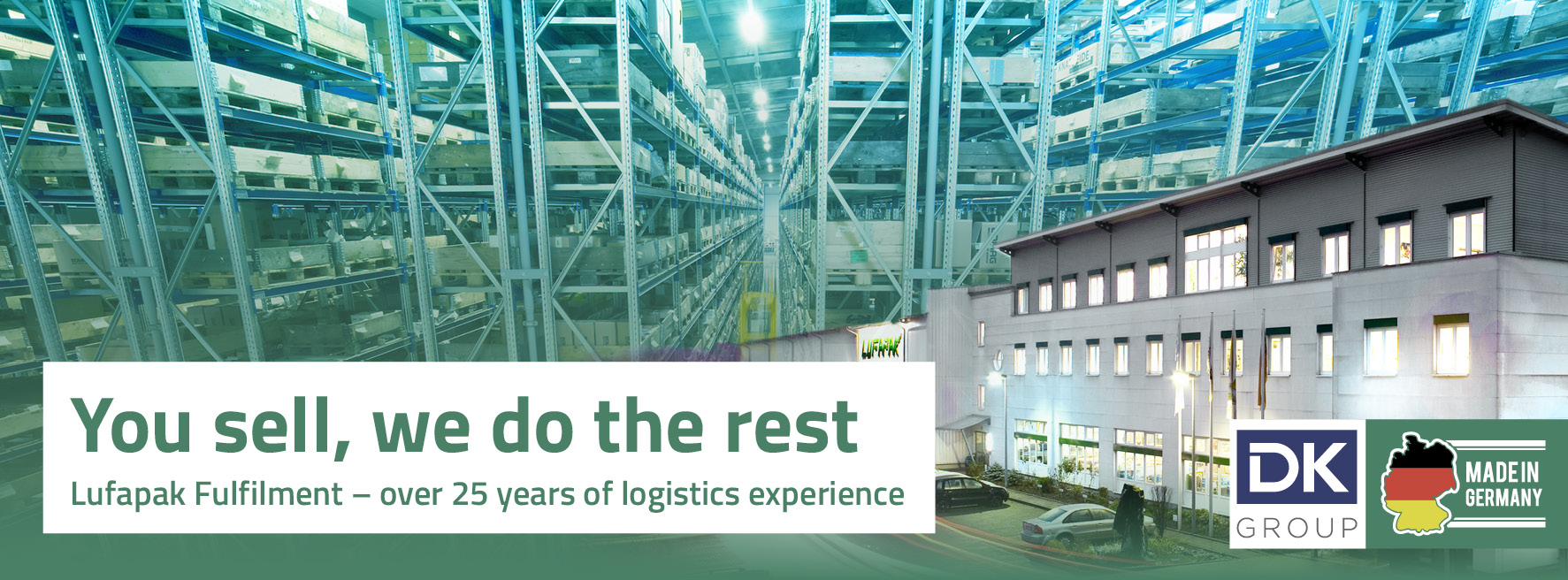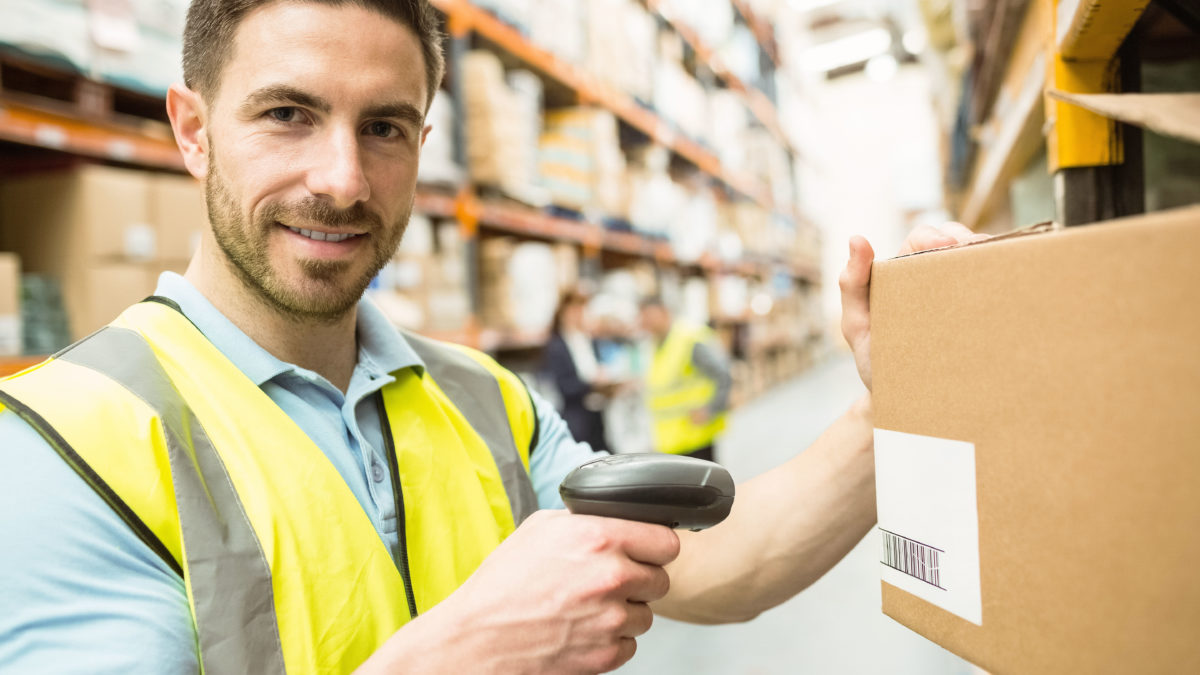sales@lufapak.de +49 2631/384-0 Contactform
What is a fulfilment centre?
A fulfilment centre is the heart of modern e-commerce logistics. These specialised facilities take over the entire processing of customer orders for online retailers. Goods of all kinds are stored in the spacious halls, ready for dispatch to end customers. The special feature is efficiency: as soon as an order is received, it is processed, packed and shipped in the fulfilment centre.
The process involves several steps. First, employees receive the goods from the retailers and store them systematically. When an order is received, they locate the items, remove them from storage and prepare them for dispatch. Modern technologies are often used to optimise the process. Barcode scanners, automated conveyor belts and intelligent storage systems are standard equipment in many fulfilment centres.
By outsourcing these processes, online retailers can concentrate on their core business. They save costs for their own storage space and personnel. At the same time, they benefit from the expertise of the fulfilment service providers, who specialise in efficient logistics processes. For customers, this usually means faster delivery times and reliable order processing.
The role of fulfilment centres in e-commerce
Fulfilment centres play a key role in e-commerce. They enable online retailers to process customer orders quickly and reliably without having to invest in their own costly logistics infrastructure. These service providers take care of all aspects of warehousing, order picking and shipping. This allows e-commerce companies to focus on their core competencies, such as product selection, marketing and customer service.
The importance of fulfilment centres is growing as e-commerce becomes more and more dynamic. They provide the flexibility needed to cushion seasonal fluctuations and sudden demand spikes. For small and medium-sized online retailers in particular, they open up opportunities to keep pace with larger competitors. By using professional fulfilment services, they can offer their customers similarly fast delivery times and a comparable service.

Fulfilment centres also contribute to the internationalisation of e-commerce. They enable retailers to store goods in different countries and ship them from there. This shortens delivery times and lowers shipping costs for international customers. At the same time, fulfilment centres make it easier to comply with local customs and tax regulations, which facilitates cross-border trade.
Core processes in a fulfilment centre
Incoming goods and storage
The receiving area marks the starting point of the fulfilment chain. This is where the products of online retailers are received, checked and prepared for storage. Employees check the deliveries for completeness and quality. They enter each product in the merchandise management system, often using barcode scanners or RFID technology. This digital recording forms the basis for efficient inventory management.
After the incoming inspection, the goods are strategically stored. Modern fulfilment centres use sophisticated storage systems for this. They place frequently sold items in easily accessible areas to minimise walking distances. Seasonal or bulky products are stored in specially designated zones. Many fulfilment centres use the chaotic storage system, in which items are not stored by category but by available space.
Storage itself takes place under consideration of product-specific requirements. Temperature-sensitive goods are stored in air-conditioned areas, while hazardous goods are kept in separate, secure zones. High-bay warehouses maximise the use of available space. Automated storage and retrieval machines and conveyor systems support employees in storage and retrieval, increasing efficiency and reducing the error rate.
Inventory management
Effective inventory management is the backbone of every fulfilment centre. It ensures that the right products are available in sufficient quantities at the right time. Modern warehouse management systems (WMS) enable real-time tracking of all stock. They record every movement, from storage to dispatch, and provide precise data on the current stock situation.
These systems also help to forecast future demand. By analysing historical sales data and seasonal trends, fulfilment centres can optimise stock levels. They identify fast and slow movers, enabling efficient warehousing. Automatic reorders when predefined minimum stock levels are reached prevent delivery bottlenecks.
Regular inventory counts are also part of inventory management. Many fulfilment centres use cyclical counts, in which part of the stock is checked daily. This enables continuous inventory control without interrupting operations. Deviations between actual and target stock levels are detected and corrected at an early stage.
Order processing
Order fulfilment is at the heart of the fulfilment centre’s activities. As soon as an order comes in, it sets a precisely orchestrated process in motion. The warehouse management system identifies the required items and their storage locations. It generates pick lists for the pickers, who are often guided directly to the products via mobile devices. This efficient route planning minimises walking distances and speeds up the picking process.
Many fulfilment centres use advanced technologies to optimise order processing. Pick-by-light systems guide employees to the right shelves using LED displays. Voice picking enables hands-free picking, where instructions are received via headphones and confirmations are given by voice. In highly automated warehouses, robots or driverless transport systems take over parts of the picking process.
After picking, the orders undergo a quality control check. Employees check the completeness and condition of the items. In multi-order picking, where several orders are processed simultaneously, the items are sorted by individual customer order at this station. The products are then packed and the necessary shipping documents are attached. Modern fulfilment centres often integrate customer-specific packaging or inserts to enhance the unboxing experience.
Packaging and shipping
The final step in the fulfilment process involves packaging and shipping the goods. This is where the art of combining efficiency with customer focus comes into play. Fulfilment centres carefully select packaging to optimally protect products while minimising shipping costs. To do this, they use a variety of box sizes, cushioning materials and specialised packaging solutions. Many centres are increasingly turning to sustainable packaging to meet the growing environmental awareness of customers.
The packing station is often highly automated. Carton erectors prepare the shipping cartons, while conveyor belts feed the picked items. Employees or robots place the products in the cartons and add filling material if necessary. Then automatic systems seal the packages and attach shipping labels. These labels contain all the relevant information for transport and enable seamless shipment tracking.
In the shipping area, employees or automatic sorting systems sort the parcels according to shipping service providers and routes. Fulfilment centres often work with several logistics partners to offer optimal shipping options for different destinations and delivery speeds. The integration of tracking systems makes it possible to provide customers with real-time information about the status of their shipment. This transparent process contributes significantly to customer satisfaction and reduces the number of customer service inquiries.
Technologies in modern fulfilment centres
Warehouse management systems (WMS)
Warehouse management systems (WMS) are the digital nerve centre of modern fulfilment centres. These complex software solutions control and optimise all warehouse processes. From incoming goods inspection and storage location management to order processing and dispatch preparation – the WMS maintains an overview and coordinates all processes. It enables real-time tracking of every single item in the warehouse and provides important data for strategic decisions.
A high-performance WMS flexibly adapts to the specific requirements of the respective fulfilment centre. It optimises picking routes, suggests efficient storage locations and controls the replenishment processes. By integrating artificial intelligence and machine learning, modern WMS solutions can predict demand and proactively adjust inventory levels. They analyse sales trends, seasonal fluctuations and historical data to optimise stock levels and avoid bottlenecks.
Connections to other systems, such as online shops or retailers’ ERP software, enable a seamless flow of information. Orders are automatically recorded in the WMS and processed in real time. At the same time, inventory information flows back to the sales platforms to ensure accurate availability display. This integration reduces manual intervention and minimises the potential for errors.
Automation and robotics
Automation is revolutionising operations in fulfilment centres. Robots and automated systems are increasingly taking over tasks that used to be performed manually. Automated guided vehicles (AGVs) move goods autonomously through the warehouse, optimising transport routes and increasing efficiency. Robotic gripper arms support picking, especially for items with standardised shapes and weights. These systems work precisely, quickly and tirelessly, which increases productivity and reduces error rates.
High-bay warehouses with automatic storage and retrieval systems maximise space utilisation and speed up storage and retrieval processes. Goods-to-person systems bring the goods directly to the employee, minimising walking distances and increasing picking performance. Automatic sorting systems in the shipping area process large quantities of parcels in the shortest possible time and direct them to the correct shipping stations.
The integration of artificial intelligence and machine learning is further advancing automation. AI-based image recognition systems support quality control and identify damaged goods. Forecasting models optimise inventory planning and dynamically adjust storage capacities. Despite the high degree of automation, humans remain an important factor in the fulfilment centre. Technology supports employees and enables them to focus on more complex tasks that require human judgement.
Advantages of using a fulfilment centre
Cost savings
Using a fulfilment centre offers online retailers significant cost advantages. Instead of investing in their own storage space and logistics infrastructure, they benefit from the economies of scale of specialised service providers. Fulfilment centres bundle the orders of many retailers, which leads to better utilisation of resources. This is reflected in more favourable conditions for warehousing, picking and shipping. In particular, this opens up the opportunity for small and medium-sized companies to benefit from professional logistics without having to bear high fixed costs.
Flexibility is another cost advantage. Fulfilment centres adjust their capacities to actual demand. In times of lower demand, costs are reduced accordingly. This flexibility preserves retailers’ capital and improves their liquidity. In addition, there are no expenses for warehouse management software, packaging material and shipping equipment. Fulfilment centres also take over the training and administration of logistics personnel, which eliminates further cost items.
By bundling shipping volumes, fulfilment centres can negotiate more favourable terms with parcel delivery companies. They usually pass these savings on to their customers. This enables online retailers to offer more competitive shipping costs or improve their margins. Returns processing is often more cost-effective in a fulfilment centre than if it is done in-house, thanks to specialised processes.
Scalability
Scalability is one of the main advantages of using fulfilment centres. Online retailers can expand their business flexibly without running into logistical obstacles. Additional storage capacity is immediately available during growth phases. This flexibility makes it possible to introduce new product lines or expand into new markets without having to invest in your own warehouse infrastructure.
Scalability proves particularly valuable when dealing with seasonal fluctuations or unexpected demand spikes. Fulfilment centres have the necessary experience and resources to overcome such challenges. They can quickly deploy additional staff or adjust processes to handle increased order volumes. This adaptability ensures that online retailers can reliably deliver even at peak times, without having to maintain excess capacity.
Geographical scalability is also an advantage. Many fulfilment service providers have a network of locations, enabling online retailers to expand step by step into new regions or countries. They can store their goods closer to the customer, which shortens delivery times and lowers shipping costs. At the same time, the risks and investments remain manageable, as no in-house facilities are required.
Focus on core competencies
Outsourcing logistics to a fulfilment centre allows online retailers to focus fully on their core competencies. Instead of investing time and resources in optimising warehouse processes, they can focus on product development, marketing and customer care. This focus on value-adding activities promotes innovation and growth.
Fulfilment centres take on complex logistical tasks that require specific expertise. They keep up to date with the latest trends and technologies and implement best practices. Online retailers benefit from this expertise without having to invest in the training of logistics specialists or the development of processes themselves. This gives them a competitive advantage, especially over larger competitors with their own logistics.
Relieving the burden of operational logistics tasks creates scope for strategic considerations. Entrepreneurs can invest more time in analysing market trends, optimising product portfolios or improving customer service. This focus makes it possible to react more quickly to market changes and develop innovative business models. Ultimately, this helps to increase customer satisfaction and consolidate the company’s market position.
Challenges and solutions
The use of fulfilment centres brings with it numerous advantages, but also some challenges. One of these is the loss of control over the logistics process. Online retailers give up some of their operational control and have to trust that the fulfilment service provider will meet their standards. To meet this challenge, many fulfilment centres rely on transparent processes and real-time reporting. Modern interfaces enable retailers to view stock levels and order status at any time.
The integration of different IT systems is another hurdle. Connecting the retailer’s merchandise management system to the fulfilment centre’s WMS often requires technical adjustments. Standardised interfaces and cloud-based solutions have proven useful here. They facilitate integration and ensure smooth data exchange. Many fulfilment service providers also offer support with system integration.
Quality assurance remains a constant challenge. Retailers must ensure that their products are handled correctly in the fulfilment centre and shipped in perfect condition. Regular audits and clearly defined quality standards help to address this issue. Some fulfilment centres offer their customers the opportunity to carry out random checks or to train employees on site.
Selecting the right fulfilment centre provider
Choosing the right fulfilment centre provider is crucial to the success of an online retailer. There are various criteria to consider. First and foremost is the service provider’s experience in the relevant product segment. A provider that already handles similar goods has the necessary know-how for efficient processing. It is worth obtaining references and asking about industry knowledge.
The geographical location of the fulfilment centre plays an important role. It influences delivery times and shipping costs. Ideally, you should choose a location that enables fast delivery to the main target group. For retailers with international operations, providers with multiple locations are a good option. They enable strategic distribution of goods, thus optimising the supply chain.
Technological aspects should also be considered. A modern warehouse management system and advanced automation solutions increase efficiency and accuracy. Seamless integration with your online store and other relevant systems is essential. Flexible interfaces and comprehensive reporting functions make day-to-day operations easier.
The provider’s scalability deserves special attention. The chosen partner should be able to keep pace with the company’s growth. This concerns both storage capacities and the ability to handle increased order volumes. Clear agreements on capacity expansions and cost scales help to secure future developments.
Future trends in fulfilment
The future of fulfilment will be significantly shaped by technological innovations. Artificial intelligence and machine learning are revolutionising forecasting and optimisation processes. They enable even more precise prediction of order volumes and dynamic adjustment of stock levels. AI-supported systems optimise picking routes in real time and adapt them to current conditions in the warehouse.
Robotics and automation will continue to advance. Collaborative robots that work safely alongside human employees are increasingly finding their way into fulfilment centres. They assist with repetitive tasks and increase efficiency. Autonomous mobile robots (AMRs) independently navigate the warehouse and bring goods to the pickers. These developments increase productivity while reducing the physical strain on employees.
Sustainability is increasingly coming into focus. Fulfilment centres are investing in energy-efficient buildings and environmentally friendly packaging solutions. Optimising transport routes and consolidating shipments helps to reduce the carbon footprint. Some providers are already experimenting with electric delivery vehicles for the last mile. These green initiatives not only meet growing environmental demands, but can also reduce costs.
The concept of decentralised fulfilment networks is gaining in importance. Instead of a few large central warehouses, companies are increasingly relying on a network of smaller fulfilment centres in and around cities. These micro-fulfilment centres enable even shorter delivery times and support same-day or even same-hour delivery options. They combine the efficiency of automated systems with the flexibility of smaller units.
The importance of fulfilment centres for e-commerce success
Fulfilment centres have established themselves as indispensable partners for success in e-commerce. They enable online retailers of all sizes to use professional logistics solutions and to hold their own in a highly competitive market. By outsourcing complex logistics processes, companies can focus on their core competencies and deploy resources for growth and innovation.
The flexibility and scalability offered by fulfilment centres are proving to be a decisive competitive advantage. They enable retailers to respond quickly to market changes and take advantage of new business opportunities. The increasing use of technology in fulfilment centres helps to further optimise processes and increase efficiency. This ultimately benefits end customers, who enjoy faster delivery times and reliable service.
Despite the many advantages, choosing the right fulfilment partner remains a critical decision. Retailers need to carefully consider which provider best suits their specific requirements. The continuous evolution of the fulfilment sector, particularly in terms of automation and sustainability, promises innovative solutions for the future. Companies that take advantage of these developments will be optimally positioned for long-term success in the dynamic e-commerce environment.
Contact us now and get advice


